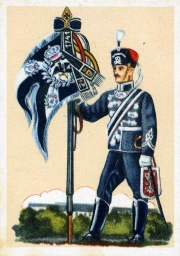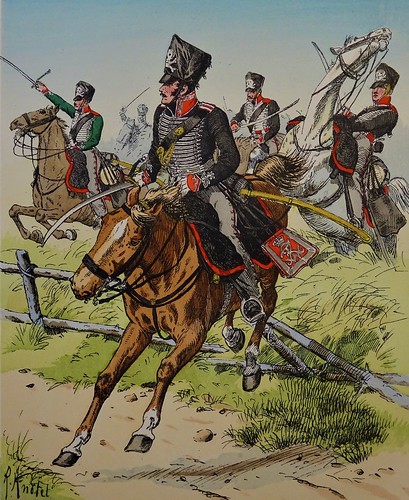1
Regiments / 1tes Leib Husaren Regiment Nr.1
« on: October 18, 2019, 11:39:39 pm »
Contacts:
Oberst: Freiherr Panda von Sachsen
Major: Artigo
 | | Line up: With the Supreme Cabinet Order (A.K.O.) of August 9, 1741 King Friedrich II donated the fifth Hussar regiment of the Prussian army, which initially received the name regiment “black hussars”. The first chief of the regiment was Major von Mackroth, whose name the Regiment did not use. By September 5, five squadrons had been set up and the places Goldap, Elk, Darkehmen, Lötzen, Oletzko, Stallupönen, Schirwindt and Pillkallen has been assigned as garrisons. Only with the second chief did the regiment, as was customary at the time, receive its name for identification and from then on it was called the hussar regiment "von Ruesch". With each change of the boss and the regiment name was changed, so the association was called: from 9. Mai 1762 Husarenregiment „von Lossow“ from 18. Oktober 1783 Husarenregiment „von Hohenstock“ from 23. Mai 1788 Husarenregiment „von Göckingk“ from 29. Dezember 1794 Husarenregiment „von Suter“ from 1804 Husarenregiment „von Prittwitz“ After the Peace of Tilsit on July 7, 1807, the Prittwitz Hussars were the only Hussar regiment of the Prussian army, which still reached full strength , since it had not participated in the Battle of Jena and Auerstedt on October 14, 1806. The regiment was divided with A.K.O. of December 20, 1808, and from it the 1st Hussar Hussar Regiment in Goldap and the 2nd Hussar Hussar Regiment in Prussian Stargard were formed. Chief of the two, always closely related regiments remained for the time being General von Prittwitz. On May 7, 1817, the 1st Hussars-Hussars moved to the new garrison in Gdansk and were renamed on May 7, 1861 in 1st Hussar Hussar Regiment No. 1. The 1st Hussar Hussar Regiment was mounted with white horses. | | Regimental Colour: Spoiler  [close] |
| Campaigns: The Hussar Regiment "von Ruesch" fought successfully 1744 in the Second Silesian War at Smatschna and Moldauthain. With the led by General von Zieten the rider attack of 22 squadron hussars on November 23, 1745 at Catholic Hennersdorf a Saxon army federation was wiped out. For the demonstrated bravery Frederick II gave the "black hussars" the captured timpani, which were led by the regiment until 1918. In the Seven Years War (Third Silesian War), the regiment attacked on 25 August 1758 in the Battle of Zorndorf. In the Bavarian War of Succession 1778/79, the hussars had been used only in the outpost and reconnaissance service. In the war against Napoleon in 1806/07, the regiment The regiment initially remained in Poland and was then sent to the Weichsel River as far as Thorn, where on June 10, 1807, at the Battle of Heilsberg where it destroyed the French 55th Line Infantry Regiment and captured their eagle On the market square of Heilsberg a monument was erected to the Prittwitz Hussars. In the War of Liberation 1813/14, the Hussars fought in the Battle of Großbeeren and in the Battle of Leipzig. After the abdication Napoleons the regiment entered Paris with the other victorious troops in Paris. During the riots in Poland in the years 1830, 1848 and 1863/64, the regiment stood as a backup on the Prussian-Russian border. In the war against Austria, the regiment fought in Bohemia and took part in the Battle of Königgrätz on 3 July 1866. In the Franco-Prussian War, the bodyguards were involved in the battle of Sedan against the troops of Emperor Napoleon III. with subsequent transfer to the South Army in the area of Orléans. On June 28, 1871, the regiment returned to its home garrison. At the beginning of the First World War, the regiment moved to the Western Front on 3 August 1914 with its sister regiment (2nd Hussar Hussar Regiment No. 2), with which it was to remain in the Brigade during the entire war. The Hussars took part in the Battle of the Marne and the battles for Arras and were relocated to the Eastern Front in the fall of 1914. Here they fought first in Galicia and in the Battle of Riga and were involved in the occupation of the islands Oesel and Dagö. To support the struggle for independence, the brigade was sent to Finland in 1917. After the peace treaty of Brest-Litovsk with Russia of March 3, 1918, the units remained as occupation troops in the Russian territories. In January 1919, the body hussars returned to Danzig, where the demobilization began and the regiment was dissolved. Until the end of the war, the 1st Huss Hussar Regiment No. 1 had retained the cavalry status. The tradition took over in the Reichswehr the 1st squadron of the 5th (Prussian) Riders Regiment in Belgard. |  | | |
1. Platoon "Totenkopfhusaren"
| 2. Platoon ""
|


